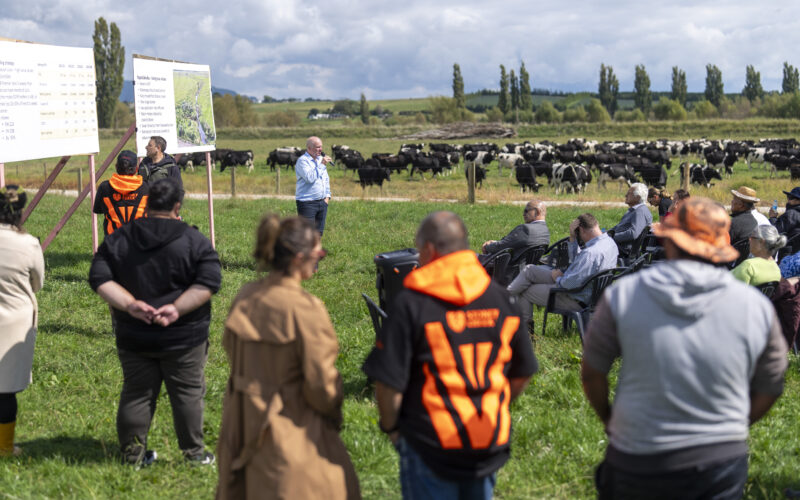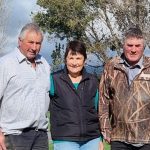
Eastern Bay of Plenty iwi keep people and innovation at the heart of the strategy for their dairy farm.
An Eastern Bay of Plenty iwi’s vision combining people, innovation, sustainability and cultural identity was conveyed to around 250 people at a field day at the Whakatōhea Māori Trust Board’s dairy farm in early April.
Whakatōhea is a finalist in this year’s Ahuwhenua Trophy competition to select the top Māori dairy farm in Aotearoa.
As part of the competition, each finalist stages a field day at their farm, giving judges and members of the public the chance to see the property.
Whakatōhea Māori Trust Board’s dairy farm, Te Riu o Kānapanapa, is a collective of five dairy farms and is located 4km south of Ōpōtiki.
Whakatōhea chief executive Dickie Farrar said she found it inspirational to see the hard work of her staff coming together, as well as to understand the tremendous effort that goes into the running of the competition, including the judging process.
Whakatōhea learnt a lot from the competition process, including by attending the field day of the other finalist, Wairarapa Moana ki Pouakani Incorporation, she said.
Ahuwhenua Trophy management committee chair Nukuhia Hadfield said Whakatōhea, like many farms in the region, had a difficult year with adverse weather conditions making for challenging times for staff trying to manage the property.
“But it was great to see just how proud Whakatōhea are of their dairy farming operation and what they have been able to achieve.
“Whakatōhea have a proud history and an impressive vision which is strongly entrepreneurial, weaving together six strategic pou: cultural identity, language and heritage, being well educated, healthy, socially connected and economically and commercially savvy.”

Among the guests on the day was Minister for Māori Development Tama Potaka.
He described the field day as outstanding, saying it was a day to celebrate Māori farming and Māori business, as well as New Zealand’s primary sector.
The judges were impressed with the farm’s strong focus on feed budgeting, monitoring and feed allocation to maximise animal performance, with staff involved throughout.
Their decisions on supplements are driven by economics with a clear understanding of production costs.
Their economic returns are part of a five-year strategy through to 2025 that is focused on further land acquisitions and climate proofing.
Whakatōhea have a comprehensive strategy and vision shared throughout their organisation that drives governance and on-farm performance that is focused on food sovereignty and sustainability.
The dairy platform is 218 hectares effective made up of 175.7ha of corpus whenua, plus an additional 29ha and a 13.3ha lease block. The farm winters 748 cows and milks 690 to peak with a production target of 300,000kg MS.
It is subdivided into 87 paddocks and runs two herds through lactation and up to four herds through winter to minimise pugging. Farm water is supplied via a bore at the cowshed and a diesel generator is there as backup.
The farm is protected from flooding by stop banks on both the Waioweka and Mill streams.
They also rear stock on a 346ha support block at the Motu, 10km north of Matawai in the Gisborne catchment. There are four permanent staff on farm and one casual, along with two calf rearers when required.
A new 60-bale rotary shed was constructed in 2013, combining what was two separate dairy units into one. The shed includes GEA technology, Protrack Vantage, in-bale teat spraying, automatic cup removers and in-shed feeding.
The milking shed is also equipped with a 600-cow feedpad that is located next to it along with a lined effluent pond, a solids bunker and silage pit.
The farm receives 1327mm of rain annually and spring can be challenging, especially during wet periods. Summer milk production is limited by C4 grass types – yellow bristle grass and paspalum.
Whakatōhea aims to maintain its farm working expenses at $6.50/kg MS for the 2024 season. Last season these expenses lifted to $7.73/kg MS.
Its environmental focus areas are based around nutrient loss in drains and streams. Native trees are planted alongside streams and drains, and the main race has been moved to reduce runoff and effluent from entering a nearby waterway.

Next year, Whakatōhea hopes to have maintained an annual operating profit of $800,000-$1m, have a return on assets of 6% and maintain livestock sales of $1/kg MS.
People are key to Whakatōhea’s success and regular team meetings are held to promote a culture of inclusiveness. All of the staff are encouraged to attend off-farm training and personal development through organisations such as Primary ITO, Growsafe and first aid.
The farm team facilitates visits from the kōhanga to give rangatahi a taste of dairy farming that hopefully sows the seeds for later in life. The farm also uses a Youth to Employment scheme that gives work experiene for young people.
Whakatōhea also has a comprehensive health and safety plan that sees all staff inducted at the start of employment. Regular meetings are held to discuss safety in the workplace and identify and minimise hazards.
To date, no ACC injury claims have been filed for the past five years.
Whakatōhea has also made major infrastructe changes to reduce the farm’s impact on freshwater and improve its biodiversity. Sensors are used to measure water quality and assess its impact on the Waioeka River. The farm is also part of the Fonterra-Nestlé greenhouse gas farmer support pilot project.
Whakatōhea’s breeding strategy centres on genetic gain and producing a cow that can be used to produce beef calves. Both sexed semen and AB are used to increase replacement numbers and add genetic gain to the herd.
The Whakatōhea Māori Trust Board joins Wairarapa Moana ki Pouakani Incorporation as the other finalist in this year’s Ahuwhenua Trophy. The winner will be announced in Hamilton on May 17.
You can now read the most important #news on #eDairyNews #Whatsapp channels!!!
🇺🇸 eDairy News INGLÊS: https://whatsapp.com/channel/0029VaKsjzGDTkJyIN6hcP1K

























